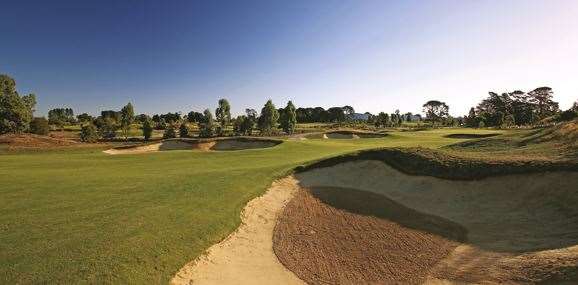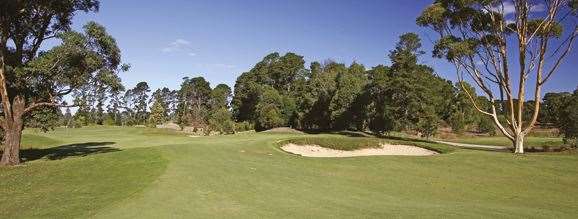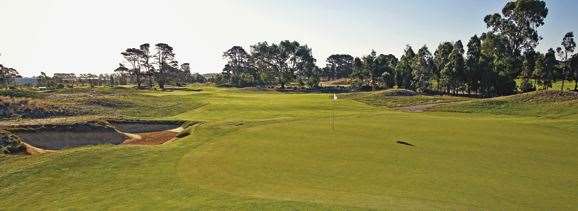It is four years since a completely rebuilt Ballarat course opened for play. The Peter Thompson and Ross Perret designed layout ha smatured and improved in that time.

Victoria has the greatest concentration of golf courses of any state in Australia. Areas like the Melbourne Sandbelt, the Mornington and Bellarine peninsulas as well as the Murray River are famous for the quality golf courses they are home to.
There are also emerging golf destinations throughout the state, including what is called the Goldfields region, with Victoria’s largest inland city, Ballarat, lying at its heart. There are several enjoyable courses to be found within 30 minutes’ drive of the historic city, but you don’t have to beat a path out of town to play the best layout the region has to offer.
Ballarat Golf Club dates back to 1895, with humble beginnings as an 11-hole course. However, this crude course lasted only two weeks as it was too short for a match or a single round and too long for a double round. It was reduced to a nine-hole course and modelled on St Andrews in Scotland.
Despite numerous changes to the course in the 115 years that followed – including the construction of an almost completely new course designed by Peter Thomson and Ross Perrett – Ballarat remains Australia’s oldest layout that is still played on part of the original course.

The Thomson and Perrett design was born out of a land deal with a local developer, which saw the exchange of land titles in 2008 and plans tabled to build the new layout on a small parcel of the original course and some adjoining land.
The new land was relatively flat when construction work began but more than 350,000 cubic metres of heavy earthworks were carried out to raise the course above the ‘paddock’ and shape the land to Thomson and Perrett’s specifications. The par-72 has a links look and feel about it, with heavy mounding in parts and deep bunkering adjoining grassy swales alongside most greens. There are few flat lies on the course with most fairways featuring subtle ripples or gentle movement of the land, which is a credit to the course shapers given the featureless nature of the land before construction.
There are clumps of mature cypress pines located in different areas of the course, while 140,000 trees, shrubs and ground-cover plants were planted during, and just after, construction to fill some areas between holes.
Thomson and Perrett’s design opened for play by the end of 2009 and during the past four years it has established a reputation as a challenging layout. Golf Australia recognised this with its ranking of Ballarat in the Top-100 Public Access Courses in the nation in January 2011 and 2013.

Ballarat is not a lengthy excursion at 6,283 metres from the back markers (5,817 from the members’ tees), but Thomson and Perrett’s design has ensured every golfer aiming to shoot a good score must think smart from tee to green on every hole.
The designers haven’t taken the driver completely out of the hands of players but – with the strategic positioning of bunkers, rough or water – they leave you open to the suggestion of a better option. Smart play is always rewarded here, where poorly executed aggressive play is penalised … sometimes harshly.
I have been to Ballarat five times during the past few years and the one constant, no matter what time of year, is the wind. There always seems to be some breeze whipping across the course, which adds to the challenge and variety of shots you will have to play, especially when you consider all holes have been routed to run to all points of the compass.
Of note, though, is the great collection of short par-4 holes. The first of these is the 319-metre par-4 3rd, which plays slightly downhill from the tee and is flanked by out-of-bounds to the left for its entire length. The rough-covered mounds down the right cut into the fairway, creating a wide tongue of rough that has been filled with a bunker, about 240 metres from the back tee. The best approach to the shallow green is from the right half of the fairway so players are left with two playing line options – play short of the fairway trap and make a longer approach, or be aggressive and bomb a drive over the left edge of the bunker and leave a short iron into the putting surface.

The following hole, a 358-metre par-4, is also worthy of mention here. It only plays about 40 metres longer than the 3rd hole but it is a far more demanding offering with water, sand and two majestic gum trees providing the defence of par. The fairway gently rises and falls over waves of small hills and narrows significantly as it squeezes past a sole bunker cut in from the right rough and lying right in the driving zone. The two gums, while wide of the fairway, can block out any approach that veers too wide of being in the centre of the fairway. The best line into the green is from the right half of the fairway, which features plenty of mounds and hollows, making a flat lie quite rare. There are no greenside bunkers, as the green is slightly elevated, with water left and swales to the right.
Another hole that is a tough proposition and demands smart play instead of brutish hitting opens the back nine. The 471-metre 10th hole could be considered a short par-5 by modern design standards but it is a genuine three-shot par-5 for most players. The out-of-bounds well left of the fairway is not of primary concern to players here … keeping your ball dry on the journey to the green is the real worry. The first of two creek crossings lies just 240 metres (it’s about a 260-metre carry from the back pegs) from the tee, which means any player with sights on reaching the green in two blows needs to be as close to this water as possible. This is a tough ask as the fairway starts sloping down to the water’s edge from about the 220-metre mark. By far the best approach into the angled-right green is from the left half of the fairway. If, like me, you can’t possibly hit two shots nearly half a kilometre, it’s best to lay up left (well away from the lake that lines the right edge of the fairway) and short of the second ‘burn’. This, however, brings a large fairway bunker on the left edge of the fairway into play. Avoid the sand and you will be left with a 8 or 9-iron or even a wedge (depending on the pin position on the massive green) for your third shot.

Ballarat’s playing surfaces have certainly matured and improved through the past four growing seasons and it is a credit to the course maintenance crew that the fairways and greens are as good as
they are when you consider the extremes of climate that can be experienced at Ballarat.
On visits to Ballarat last year, I saw light snow at the tail end of winter and 30˚ heat only a month later, yet the Santa Ana couch fairways and G2 bentgrass greens played the same, and really only differed in colour.
What I like most about the greens is the firmness and speed of them. They are large putting surfaces, so are quite receptive to low, running shots played from the correct positions.

THE COURSE
LOCATION: Sturt St, West Ballarat. Approximately 110km, north-west of Melbourne, via the Western Freeway.
CONTACT: (03) 5338 3017.
WEBSITE: www.ballaratgolfclub.com.au
DESIGNER: Peter Thomson & Ross Perrett (2009).
PLAYING SURFACES: Santa Ana couch (fairways), G2 bentgrass (greens & surrounds), fine fescues including Sheep’s and Creeping Red (rough).
COURSE SUPERINTENDENT: Jeff Powell.
PGA PRO: Dominic Azzopardi (AAA-rated).
GREEN FEES: $30 (weekdays), $40 (weekends). Carts: $40.

THE CLUB
MEMBERSHIPS: Ballarat has eight membership categories from a limited golf membership to ordinary member status, which grants the member full playing rights seven days a week, and costs $1,055 a year.
CORPORATE AND GROUP DAYS: Ballarat Golf Club’s modern clubhouse offers a variety of spacious conference facilities. A blend of the best in hospitality facilities set against the backdrop of the course.
ACCOMMODATION: The Bell Tower Motel is located across the road from the course and offers quality accommodation along with an indoor pool and spa, gymnasium and restaurant.
FACILITIES: The club, PGA pro Dominic Azzopardi and MIA Sports Technologies have collaborated to open regional Victoria’s only Tech Centre. The technology in the centre (adjoining the pro shop) includes fixed
high-speed video cameras and GASP teaching software. Incorporating both swing and putting analysis through Flightscope and Sam Putt Lab, players can experience a level of ball trajectory measurement and tracking that is hard to beat. Enquiries (03) 5338 3010.
Related Articles

Review: Omaha Beach Golf Club

Drinks With... Ricky Ponting













